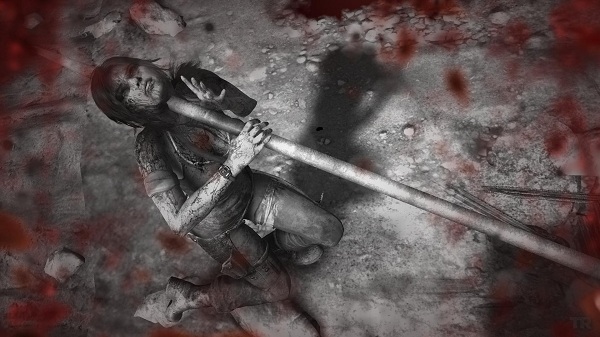Narrative has been a major talking point in gaming circles over the last couple of years. Whether it’s the rise of story-centric exploration games like Dear Esther, Gone Home and The Stanley Parable or the question of social issue and representation in game writing (as evidenced by Anita Sarkeesian’s hugely fretted-over Tropes Vs. Women in Video Games), signs have been abundant that narrative is the new frontier on which games have become expected to push forward to maturity as entertainment and in cultural significance.
The thing is, nobody’s really looking at games in purely narrative terms. We’re accustomed to taking about mechanics when we talk about games, because that’s how we’ve always been programmed to look at them. But right now we’re grappling with the issue of whether games can actually tell stories as well as other media, and what place mechanics has in that process – or vice versa.
That brings us to this, this first installment of a new column: Storytime With MCP. Here, we’re going to look at games in terms of how they stand as narratives first and foremost. Mechanics will also be considered, but only is as much as they support or contradict the story the developers are trying to tell; the main idea, however, is to look at videogame stories to the same standards we normally hold for film or literature, and see where they succeed and/or fail.
For our first entry, we’re looking at a recent game that was marketed quite heavily on story and character, albeit rather notoriously so…
WARNING: SPOILERS ABOUND
Tomb Raider (2013) was marketed as a ‘soft reboot’, i.e. a new take on the property that also links to the established canon – in this case, a prequel featuring Lara Croft’s first adventure, and the formative experience that helped mold her into the globe-trotting badass we first met back in 1996. Naturally, however, as a rebootquel it allows itself a bit of wiggle room, most noticeably with a drastic change of tone from the rest of the series. Gone was the fantastical pulpiness of before, replaced by a grittier, darker tone with a Lara developer Crystal Dynamics claimed repeatedly in previews we would ‘want to protect’.
But does this new focus on character make for a more mature Tomb Raider, or just a messier one?
 Let’s start with the good stuff. The game succeeds in its goals – at least partly – by making Lara a more relatable, emotionally centred character. This is largely due to Crystal Dynamics’ secret weapon: actor Camilla Luddington. While Lara is solidly written (By two women, Susan O’Connor and Rhianna Pratchett) Luddington’s voice and mocap work brings a spark of genuineness to Lara, making her feel alive in a way we haven’t seen in previous versions of the character, or in most videogame protagonists for that matter. This is a Lara Croft who comes with the sense of an inner life and emotional depth, and Luddington does a good job of showing the qualities that will allow Lara to become the accomplished adventurer we all know and love (Or at least, a new iteration of that Lara).
Let’s start with the good stuff. The game succeeds in its goals – at least partly – by making Lara a more relatable, emotionally centred character. This is largely due to Crystal Dynamics’ secret weapon: actor Camilla Luddington. While Lara is solidly written (By two women, Susan O’Connor and Rhianna Pratchett) Luddington’s voice and mocap work brings a spark of genuineness to Lara, making her feel alive in a way we haven’t seen in previous versions of the character, or in most videogame protagonists for that matter. This is a Lara Croft who comes with the sense of an inner life and emotional depth, and Luddington does a good job of showing the qualities that will allow Lara to become the accomplished adventurer we all know and love (Or at least, a new iteration of that Lara).
The problem is, there’s still a game to play in the process. Lara may be a scared, vulnerable girl relying on her innate strength to get through an impossibly traumatic situation by the skin of her teeth, but when the player takes over she’s leaping hither and tither and dropping bandits like a particularly homicidal gazelle, albeit one that can’t shut up about how unused it is to all this death-dealing. The early stages of the game, skirt around this issue until she has to kill a man for the first time, an event handled with a long and hugely melodramatic cutscene with Lara gunning down a bandit who tries to rape her, then suffering an emotional breakdown as she realizes that she’s just taken a life.
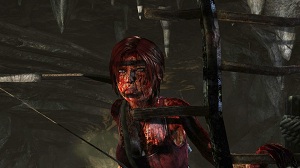 Then you take over and guide her as she goes on to take out a dozen more guys with a fraction of the difficulty of the first one. And this is just one level we’re talking about here: when you’re barely past the half-way point of the game and already getting the trophy for looting two hundred downed enemies, the game’s insistence on pushing the ‘helpless bookworm’ angle starts to look more than a little ludicrous. And that’s not even getting into her sudden expertise in modifying weaponry with scrap metal, or the rampant wildlife-killing that yields nominal salvage and seems to be there purely for the kind of for-the-sake-of-it trophy hunting the game seems at pains to suggest over and over that Lara herself would not be into.
Then you take over and guide her as she goes on to take out a dozen more guys with a fraction of the difficulty of the first one. And this is just one level we’re talking about here: when you’re barely past the half-way point of the game and already getting the trophy for looting two hundred downed enemies, the game’s insistence on pushing the ‘helpless bookworm’ angle starts to look more than a little ludicrous. And that’s not even getting into her sudden expertise in modifying weaponry with scrap metal, or the rampant wildlife-killing that yields nominal salvage and seems to be there purely for the kind of for-the-sake-of-it trophy hunting the game seems at pains to suggest over and over that Lara herself would not be into.
It’s the product of a dilemma that’s always plagued prequels. Part of the appeal of old-school Lara was her sense of expertise. Like her inspiration Indiana Jones, her wealth of knowledge put her a cut above your average action hero, the sense that her capability was built upon many years of experience, countless adventures that gradually shaped her into the cool-headed badass we know. But if you want to do her origin story, and introduce her as this resourceful but essentially unskilled and vulnerable babe in the woods, you have the problem of how you pitch this vulnerability and how long you want to sustain it in gameplay terms. If you stick to the concept, you’re potentially making the player spend an entire fifteen-to-twenty-hour game stumbling around not being able to shoot straight and possibly getting shot in the face every five seconds. What the player won’t get is the classic Lara Croft experience, i.e. leaping around levels with the grace of a gymnast while plugging baddies with deadly accuracy – skills a realistic Lara will still need years to fully develop.
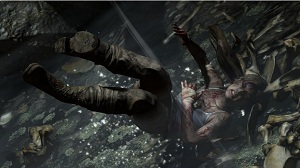 Of course, no-one would play this so instead Crystal Dynamics have her develop these skills over what is essentially a really, really shitty weekend. In practical gameplay terms it makes sense, but it also undermines this new, realistic take on Lara. The game tries to explain this away with genetics, with Lara’s mentor Roth repeatedly reminding her that she takes after her adventurer dad, and Luddington works hard to try and sell Lara’s fear and lack of confidence while she performs these superhuman acts of endurance. However, at the end of the day this is a Tomb Raider game, and you don’t have a Tomb Raider game without climbing, big jumps and gunslinging – all of which is beautifully handled and incredibly fun to do, as long as you can wilfully forget that player-Lara appears to be several years of training and experience ahead of where story-Lara should be.
Of course, no-one would play this so instead Crystal Dynamics have her develop these skills over what is essentially a really, really shitty weekend. In practical gameplay terms it makes sense, but it also undermines this new, realistic take on Lara. The game tries to explain this away with genetics, with Lara’s mentor Roth repeatedly reminding her that she takes after her adventurer dad, and Luddington works hard to try and sell Lara’s fear and lack of confidence while she performs these superhuman acts of endurance. However, at the end of the day this is a Tomb Raider game, and you don’t have a Tomb Raider game without climbing, big jumps and gunslinging – all of which is beautifully handled and incredibly fun to do, as long as you can wilfully forget that player-Lara appears to be several years of training and experience ahead of where story-Lara should be.
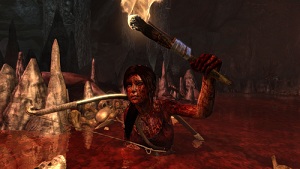 But then again, this is hardly a subtle game. If the explosions of murder-angst don’t clue you in, the torsos surely will. One of the weirdest trends to develop in western games over the last couple of years has been art direction that makes liberal use of rotting corpse piles. This is the third game I’ve played in the space of a couple of weeks that has you crawling over/through at least one pile of half-liquefied body parts (The others being Outlast and Kingdoms of Amalur: Reckoning, with Spec Ops: The Line also lingering in the memory for the same thing). It can be an annoyingly unsubtle device, like these games are being made by fourteen-year-olds who think that the ultimate in ‘being edgy’ is making everything look like a Cannibal Corpse album cover, and if anything Tomb Raider represents the trend at its worst. Why do these cultists and giant mythical samurai things insist on having dissected torsos lying around everywhere? Have these people ever heard of OH&S? Why is Lara crawling through a tunnel made of guts? Why is the literal lake of blood she’s just fallen into not congealed? And considering she’s just nearly drowned in several hundred other people’s plasma, why isn’t Lara infected with such ridiculous quantities of hepatitis she’d qualify as a one-woman Mötley Crüe?
But then again, this is hardly a subtle game. If the explosions of murder-angst don’t clue you in, the torsos surely will. One of the weirdest trends to develop in western games over the last couple of years has been art direction that makes liberal use of rotting corpse piles. This is the third game I’ve played in the space of a couple of weeks that has you crawling over/through at least one pile of half-liquefied body parts (The others being Outlast and Kingdoms of Amalur: Reckoning, with Spec Ops: The Line also lingering in the memory for the same thing). It can be an annoyingly unsubtle device, like these games are being made by fourteen-year-olds who think that the ultimate in ‘being edgy’ is making everything look like a Cannibal Corpse album cover, and if anything Tomb Raider represents the trend at its worst. Why do these cultists and giant mythical samurai things insist on having dissected torsos lying around everywhere? Have these people ever heard of OH&S? Why is Lara crawling through a tunnel made of guts? Why is the literal lake of blood she’s just fallen into not congealed? And considering she’s just nearly drowned in several hundred other people’s plasma, why isn’t Lara infected with such ridiculous quantities of hepatitis she’d qualify as a one-woman Mötley Crüe?
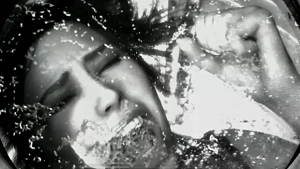 Then again, blood-based infections are the least of what poor Lara goes through over the course of this game. She gets impaled, half-drowned, thrown into rock walls by explosions, caught in an animal trap, graphically beaten by cultists, and all of this is by the time you reach the halfway point of the game, and played out in meticulous detail in lengthy cutscenes. While ‘torture porn’ is a slightly melodramatic way to describe it, it’s certainly morbid and a slightly pushy way to keep impressing Lara’s vulnerability upon us, especially since none of this suffering has any noticeable effect on her, or stops her from being a bulletproof action machine, in gameplay. Instead it comes across as cheap manipulation that’s indulgent in not-entirely-settling ways, creating in tandem with the aforementioned gore-based fung shui a rather ugly tone that looms large over the game to the point of ridiculousness.
Then again, blood-based infections are the least of what poor Lara goes through over the course of this game. She gets impaled, half-drowned, thrown into rock walls by explosions, caught in an animal trap, graphically beaten by cultists, and all of this is by the time you reach the halfway point of the game, and played out in meticulous detail in lengthy cutscenes. While ‘torture porn’ is a slightly melodramatic way to describe it, it’s certainly morbid and a slightly pushy way to keep impressing Lara’s vulnerability upon us, especially since none of this suffering has any noticeable effect on her, or stops her from being a bulletproof action machine, in gameplay. Instead it comes across as cheap manipulation that’s indulgent in not-entirely-settling ways, creating in tandem with the aforementioned gore-based fung shui a rather ugly tone that looms large over the game to the point of ridiculousness.
Unfortunately, this lack of subtlety also makes the characters around Lara a bit of a chore. The game has a lot of characters in its cast but they’re essentially props, a grab-bag of stereotypes there to either reinforce what a good person Lara is or to provide an obstacle of some kind. You have a black woman who’s sassy and aggressive, a huge islander guy who’s full of folk tales about mystical stuff, a mentor with fatherhood issues who dies right at the point Lara needs to come into her own, a vain celebrity archaeologist who turns out to be a bit of a coward, the ship’s helmsman, a Scotsman who’s so dour his actual fucking name is Grim, and Lara’s bestie Sam whose only notable characteristic is a Princess Peach-level propensity for getting kidnapped by hammy cult leader Mathias.
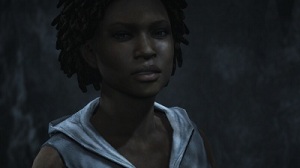 The extent to which the script is uninterested in these side characters is made clearest in the story of Roth (The mentor) and Reyes (Sassy Black Woman). One of the many things Lara discovers thanks to everyone’s habit of strewing diary entries throughout the island, is that Reyes has been having a years-long secret affair with Roth, who is unaware that he is father to her young daughter back home. The story makes this important in order to set up Reyes’ dislike of Lara, whose close, almost paternal relationship with Roth it is suggested she envies.
The extent to which the script is uninterested in these side characters is made clearest in the story of Roth (The mentor) and Reyes (Sassy Black Woman). One of the many things Lara discovers thanks to everyone’s habit of strewing diary entries throughout the island, is that Reyes has been having a years-long secret affair with Roth, who is unaware that he is father to her young daughter back home. The story makes this important in order to set up Reyes’ dislike of Lara, whose close, almost paternal relationship with Roth it is suggested she envies.
When Roth is killed protecting Lara late in the game, we are set up to expect an appropriately momentous emotional reaction from Reyes. However, while Lara gets a lengthy, tear-soaked cutscene as she wails over Roth’s body, Reyes gets to utter one word – ‘No…’, in monotone – before griping at Lara a little more and promptly disappearing again with the others for another huge chunk of the game. She doesn’t actually reveal the truth about her and Roth, or even sound any more upset than she would’ve been if it had been anyone else in the crew who was killed, and her actual time with the body of her dead lover amounts to about ten seconds tops.
Even worse, sitting right in front of Lara after this cutscene concludes is yet another convenient journal in which Roth admits – IRONY ALERT – that he considers her the daughter he never had. Not only is Roth’s death made all about Lara, the mother of his actual child gets precisely one syllable to grieve while the focus is kept on Lara’s reaction to everything. Naturally, Reyes learns to trust Lara and never mentions Roth again; a rather crappy way to treat a character who’s had pretty fair reasons to feel the way she does throughout the story. But the game isn’t really interested in her or Roth, or any of the crew for that matter: they’re simply props the game waves about when it wants to show something about Lara. This, of course, is pretty much their purpose – I mean, they are secondary characters for a reason – but there’s such a thing as making it too obvious, which really doesn’t help the game’s incessant sturm und drang. The game constantly tells that we have to care about these characters while making no effort to give us anything to care about, the little character development they have being confined to that hoariest of narrative cheats, the audio log – here taking the form of diary entries scattered for some reason across the island, among those of various soldiers, generals, cultists and Himiko’s subjects. Apparently this place is great for writers’ block.
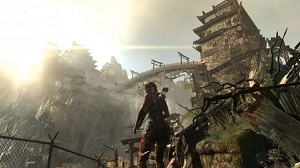 One thing the story does get right, conceptually at least, is the mystical side. The lost kingdom of Yamatai, with its combination of ruins ranging from ancient Japanese, to WWII and modern victims, makes for an interesting place to explore and the mystery of the ruthless Sun Queen Himiko is genuinely interesting and is one of the few things in the game that feels like classic Tomb Raider – ditto the actual tombs, which are fun if too sparse and easily-solved. That said, as the game reaches its final stages the concept feels somewhat underutilized, with the story of Himiko and her subjects basically confined to audio logs while the dull as dishwater, torso-hoarding cultists get the main focus. Even Himiko herself gets little material despite an interesting device by which Lara pieces together her story while talking ‘to’ her, establishing a kind of centuries-divided relationship between the two that is seemingly tossed aside when Himiko finally turns up as a glowy spirit thing who is rapidly dispatched without as much as a line of dialogue to justify all this setup.
One thing the story does get right, conceptually at least, is the mystical side. The lost kingdom of Yamatai, with its combination of ruins ranging from ancient Japanese, to WWII and modern victims, makes for an interesting place to explore and the mystery of the ruthless Sun Queen Himiko is genuinely interesting and is one of the few things in the game that feels like classic Tomb Raider – ditto the actual tombs, which are fun if too sparse and easily-solved. That said, as the game reaches its final stages the concept feels somewhat underutilized, with the story of Himiko and her subjects basically confined to audio logs while the dull as dishwater, torso-hoarding cultists get the main focus. Even Himiko herself gets little material despite an interesting device by which Lara pieces together her story while talking ‘to’ her, establishing a kind of centuries-divided relationship between the two that is seemingly tossed aside when Himiko finally turns up as a glowy spirit thing who is rapidly dispatched without as much as a line of dialogue to justify all this setup.
Self-consciousness clings to Tomb Raider like a wet t-shirt emblazoned with the logo of a post-traumatic stress disorder clinic. Its status as reboot-cum-prequel means that it can never completely emerge from the shadow of the original Lara, a female character who, in an industry whose main audience was teenagers, dared to exist without needing a white knight and inspired millions in the process.
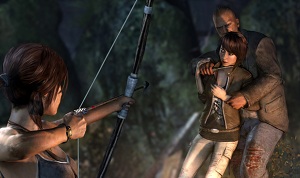 New Lara arrives at a time when the audience is predominantly in their thirties, in a game that tries to assert its own identity by pushing for grittiness at every possible opportunity. It may repeatedly sing the praises of her strength and resourcefulness, but in truth she’s constructed as needing a white knight: the player himself, and I use the word ‘himself’ very specifically. As I entered the game’s climax, striving to rescue an abused Sam dressed in virginal white robes from a cackling madman and a mute female demigod, I realized what it was that had been bugging me about the game’s treatment of Lara. It doesn’t feel like it was made for the legions of female fans who have stuck by the character for almost twenty years; it feels like it was made for gamers today, and male gamers at that. I don’t believe that this was intentional, but I couldn’t shake the feeling that O’Connor and Pratchett did the best they could with a character that missed the point from the initial stages of conception. All in all, what we get here is Lara as a kind of reverse Samson: give her TressFX and she loses her power.
New Lara arrives at a time when the audience is predominantly in their thirties, in a game that tries to assert its own identity by pushing for grittiness at every possible opportunity. It may repeatedly sing the praises of her strength and resourcefulness, but in truth she’s constructed as needing a white knight: the player himself, and I use the word ‘himself’ very specifically. As I entered the game’s climax, striving to rescue an abused Sam dressed in virginal white robes from a cackling madman and a mute female demigod, I realized what it was that had been bugging me about the game’s treatment of Lara. It doesn’t feel like it was made for the legions of female fans who have stuck by the character for almost twenty years; it feels like it was made for gamers today, and male gamers at that. I don’t believe that this was intentional, but I couldn’t shake the feeling that O’Connor and Pratchett did the best they could with a character that missed the point from the initial stages of conception. All in all, what we get here is Lara as a kind of reverse Samson: give her TressFX and she loses her power.
Tomb Raider takes itself far more seriously than its own story can support, and the more it tries to convince the player how sophisticated and ‘edgy’ it is the more its propensity to settle for comfortable but lazy stereotype stands out. Is the game fun? Absolutely. In fact, I’ve now played the game twice: the first time on PC, then the Definitive Edition on PS4. The first time was a frustrating experience, with the story and tonal choices taking the fun out of the gameplay. With time I wondered if I was being unfair on the game, hence the second playthrough which informed me that in a lot of ways, I was. Tomb Raider is a wonderfully playable game, with strong traversal and combat mechanics combining with a strong central performance to create a hugely enjoyable time… If you remember to not take the story seriously.This is, of course, something we do all the time with games, and in most cases there’s nothing wrong with it in and of itself. Many games basically amount to great mechanical experiences with writing that is serviceable, or even deliberately inundated with cliches and references specifically to evoke a comforting shorthand for the player.
 With Tomb Raider, however, it’s clear that Crystal Dynamics wanted more. They went to a lot of effort to make Lara more than just another unengaging videogame protagonist in a disposable plot, and while with Camilla Luddington’s help they went a long way to achieving the former they are ultimately undone by an inconsistency of tone and a paucity of inspiration when it comes to marrying the pulpy concept of Lara Croft with a contemporary sense of grit. The result is an unsubtle mess of a story that wants to have its cake and eat it, with a genuinely ugly streak that makes being Lara much less fun than it used to be.
With Tomb Raider, however, it’s clear that Crystal Dynamics wanted more. They went to a lot of effort to make Lara more than just another unengaging videogame protagonist in a disposable plot, and while with Camilla Luddington’s help they went a long way to achieving the former they are ultimately undone by an inconsistency of tone and a paucity of inspiration when it comes to marrying the pulpy concept of Lara Croft with a contemporary sense of grit. The result is an unsubtle mess of a story that wants to have its cake and eat it, with a genuinely ugly streak that makes being Lara much less fun than it used to be.
On the other hand, there’s certainly scope for a more ‘mature’ version of Lara Croft, one hopes that next time they can cast off the ‘defenceless rookie’ shackles and let Lara be awesome again, especially if they keep Luddington on board. Crystal Dynamics just need to employ a bit of narrative subtlety and a lighter touch, and with these gameplay mechanics have a shot at producing an amazing new-gen Tomb Raider game.

